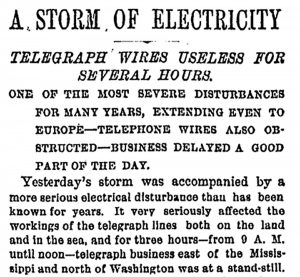The Great Sun Storm of 1859
I was perusing old newspapers online the other day and learned about the Great Sun Storm of 1859. The newspapers.com site was marking the 160th anniversary of the event. Here is what happened:
The night sky of August 28th, 1859, in much of the United States, was cloudless with a new moon just forming. In Vermont, eyewitnesses at 7:30 P.M. reported “a large fire behind the mountain.” Soon spires of green shot up from the behind the same mountain, which coincidentally is part of the Green Mountains range. The Vermont Chronicle in Bellows Fall reported, “the heavens were lighted up with a display of the Aurora… streamers shooting up, like the frame of a glorious dome, from every point of the compass, and meeting, for a moment, in a waving auroral crown at the zenith – darks purplish auroral banks lying at the north and south simultaneously like two hostile armies with unfurled banners and flashing swords…”
 The writer had a way with words.
The writer had a way with words.
These storms result from large variations in the solar wind, which affects Earth’s magnetosphere. The transfer of energy from that solar wind creates the spectral and beautiful patterns of light witnessed in 1859.
It was the most violent solar storm ever documented, coming on the eve of the Civil War. The storm was one of two that reached the earth within a few days. It lit up skies around the world from Cincinnati to Sydney, Australia. In Tasmania, the storm sent bands of glorious colors across the skies: “A light blue with a tint of green blending into second, a very light yellow green, again blending into third, a deep red, the reddy scintillations throughout this coloured light, like opening of a lady’s fan…”
Crowds gathered in the streets of New York City to see the event, and the light was said to be bright enough to read the time on the face of a watch. Up in the Rocky Mountains, a group camping outside were awakened by the auroral light. Some concluded daylight had arrived and began cooking breakfast.
According to the New York Herald, up to 125,000 miles of telegraph line existed in the whole world in 1859, primarily in the United States, Australia, India and much of Europe. The first storm disrupted the lines throughout the world. In a number of cases, telegraph operators were able to disconnect their batteries and operate on what was called the “auroral current.”
Aurora borealis, known commonly as the Northern Lights, are a well-known phenomenon, though one must travel pretty far north to witness them. (Or head toward the South Pole.) But nothing like the storm of 1859 has been witnessed before or since that episode, 160 years ago. The New Orleans Daily Picayune reported: “Crowds of people gathered at the street corners, admiring and commenting upon the singular spectacle. Many took it to be a sign of some great disaster or important event, citing numerous instances when such warnings have been given.”
In Columbus, Ohio, a 16-year-old girl became “deranged.” Her “agitated state necessitated that she be moved to the lunatic asylum.” In the Garden District of New Orleans, “several denizens of that delightful spot have been found drunk – many under a strange delusion, having taken the gutter for their own comfortable beds,” according to the Daily Picayune.
A New York Times article in 2003 surmised that if the earth suffered a sun storm of similar intensity today, the effects would be quite devastating. Electric power grids all over the world could be knocked out, much as the telegraph lines of 1859 were temporarily put out of service. It could even derail low-orbit communication satellites. Add that to your plate of worries if you are so disposed.
In 1859, Altoona (Pa.) Tribune reported: “The editor of the Kittanning Free Press states that many persons were badly frightened by the auroral display. Some imagined that the world was about to end, and declared that they smelt brimstone. Maybe they had a good reason for it.”
Indeed, maybe they did.
Leave a reply
Fields marked with * are required











